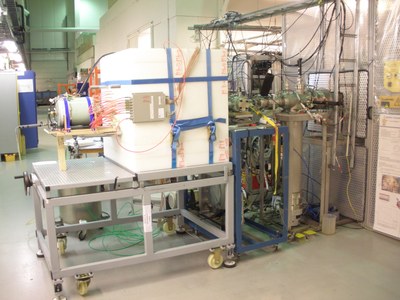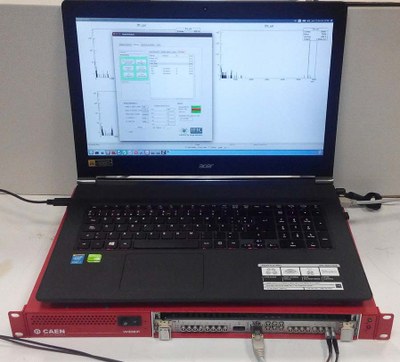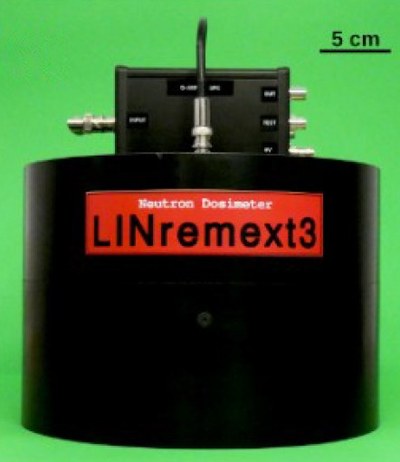Detector design
miniBELEN-10A: A Reconfigurable Neutron Counter for Alpha-Induced ReactionsminiBELEN-10A: A Reconfigurable Neutron Counter for Alpha-Induced Reactions with Remarkable Consistency with data Neutrons play a critical role in various scientific fields, including nuclear astrophysics, underground physics, and nuclear technologies. However, much of the existing data on how alpha particles induce neutron emission – (alpha, n) reactions – is outdated, incomplete, or lacks precision. The MANY (Measurement of Alpha Neutron Yields) collaboration aims to address this gap by developing advanced neutron detection systems. miniBELEN-10A: miniBELEN-10A, is a novel neutron counter designed for the MANY project. It builds upon previous BELEN-type detectors, offering a groundbreaking advantage: reconfigurable design. This allows us to adapt the detector to various experimental needs. Instead of being limited to a single configuration, miniBELEN-10A offers the flexibility of multiple tools in one. Most importantly, miniBELEN-10A boasts a "flat" efficiency – it can detect neutrons with nearly equal effectiveness across a broad energy range (up to 8 MeV). This flat efficiency is crucial for obtaining accurate measurements of neutron yields from (alpha, n) reactions. How it Works: miniBELEN-10A utilizes a key component to achieve its flat efficiency: strategically placed cadmium inserts. By carefully positioning the cadmium within the detector, neutrons of specific energies are absorbed, and the flatness of the energy response is improved. At the heart of miniBELEN-10A lie ten helium-3 detectors, embedded within a high-density polyethylene (HDPE) moderator. The moderator slows down neutrons, making them easier to be detected with helium-3 proportional counters. The Power of Reconfiguration: The true strength of miniBELEN-10A lies in its reconfigurable design. The HDPE moderator, comprised of smaller blocks, can be disassembled and reassembled in different configurations. This allows us to tailor the detector's response to the specific requirements of any given experiment. Testing and Validation: The critical test for miniBELEN-10A came in the form of measuring the well-established neutron yields produced by the reaction between alpha particles and aluminum-27 – 27Al(alpha, n)30P) –. This is a well-known reaction in the scientific community, providing a benchmark for the detector's accuracy. miniBELEN-10A's measurements closely matched the data from previous experiments, demonstrating exceptional agreement within the margin of uncertainty. This successful validation confirms the detector's ability to deliver reliable and consistent results for studying (alpha, n) reactions. key Takeaways:
Future Implications: miniBELEN-10A paves the way for more precise measurements of (alpha, n) reactions, leading to a deeper understanding of various nuclear processes. This knowledge can benefit diverse fields, from astrophysics to nuclear technology development. Further information: - miniBELEN: a modular neutron counter for (alpha, n) reactions, N. Mont et al. - Commissioning of miniBELEN-10A, a moderated neutron counter with a flat efficiency for thick-target neutron yields measurements, N. Mont et al. |
Beta-delayed Neutrons. The BELEN DetectorUnveiling the Secrets of Exotic Nuclei: Radioactive isotope facilities play a crucial role in exploring the properties of exotic nuclei, particularly those rich in neutrons. However, venturing into this neutron-rich territory presents a unique challenge beta-delayed neutrons. Beta-delayed neutrons and their significance: As the neutron-richness increases, the neutron separation energy (Sn) decreases, leading to a new decay mechanism: beta-delayed neutron emission. These "beta-delayed neutrons" (βn) are crucial for:
Enter BELEN: Pioneering Neutron Detection The BELEN (BEta-deLayEd Neutron detector) is a detector designed to measure beta-delayed neutron emission probabilities of nuclei of interest in nuclear technology and physics. Simple design, high efficiency: BELEN consists of a set of rings made of thermal neutron detectors (He-3) embedded in a high-density polyethylene (moderator) matrix. This design offers high detection efficiency within a predefined neutron energy range. A legacy of success: The BELEN concept has been used in numerous experiments at leading facilities like GSI (Germany) and IGISOL (Finland). Different versions, optimized for specific energy ranges, have been developed by UPC and the Experimental Nuclear Physics group of IFIC. These versions, utilize a digital electronic trigger-less data acquisition system (Gasific) for accurate measurements.
BELEN-20 neutron detector at IGISOL facility (University Jyväskylä, Finland)
BELEN-48 neutron detector at IGISOL facility (University Jyväskylä, Finland) DAQ using Gasific (IFIC, Valencia) BRIKEN: The World's Most Efficient Neutron Detector Array Building upon BELEN's success, BRIKEN (BELEN for RIKEN) stands as the world's most efficient neutron detector array. This innovation boasts 140 He-3 tubes strategically arranged in a seven "pseudo-ring" geometry. BRIKEN has been instrumental in a long-lasting experimental campaign at RIKEN (2016-2021) and can even, to some extent, measure neutron energy spectra, a capability absent in previous BELEN iterations.
BRIKEN detector geometry
BRIKEN detector at RIKEN facilities (Japan) BRIKEN and AIDA detectors at RIKEN(Japan) The future: With the BELEN concept, we continue to push the boundaries of nuclear science, unveiling the secrets of exotic nuclei and contributing to advancements in nuclear structure, astrophysics, and reactor technology. While each BELEN ring can be approximated as a Bonner sphere, further development is ongoing to extract neutron energy information through advanced unfolding techniques. |
HENSA and NESTAUnveiling HENSA and NESTA: Powerful Tools for Precision Neutron Detection HENSA: High-Efficiency Neutron Hunter HENSA, the High Efficiency Neutron Spectrometry Array, is a cutting-edge detector system born from a collaborative effort of eight leading research institutions. This innovative technology offers exceptional energy resolution, ranging from meV to GeV, making it ideal for studies in low-radioactivity environments like underground laboratories and cosmic-ray investigations. Understanding the Neutron Challenge Ever-present neutrons, hailing from cosmic rays and natural radioactivity, bombard our world. This constant barrage forms a background radiation that poses a three-fold challenge:
HENSA's strength lies in its ability to precisely measure this neutron flux. By dissecting this radiation, researchers can not only identify its sources but also assess their impact on various scientific endeavors and technological applications. Diverse Applications of HENSA
Neutron Spectrometry Array located at the tunnel of LSC (Canfranc, Huesca) HENSA's Superiority: Beyond Detection Unlike traditional detectors, HENSA offers both high-efficiency neutron detection and detailed energy information. This enhanced sensitivity translates to several crucial advantages:
HENSA in Action: Mapping the Neutron Landscape The first HENSA campaigns have yielded valuable data. They successfully measured neutron fields within the LSC underground laboratory and mapped cosmic-ray neutron flux across various locations in Spain. This information provides crucial insights into the impact of neutrons on different experiments and geographical regions.
Neutron Spectrometry Array at Astun, Huesca (2100 m)
Neutron Spectrometry Array at ETSEIB, Barcelona (120 m)
Neutron Spectrometry Array at LSC facilities (Canfranc, Huesca) NESTA: HENSA's Agile Sibling NESTA, the Nested Neutron Spectrometry Array, is a portable version of HENSA designed for the fast-paced environment of accelerator facilities. Optimized for the n_TOF facility at CERN, NESTA inherits several key features from HENSA:
NESTA, high-density polyethylene matrix for n_TOF-CERN The Future of Neutron Detection HENSA and NESTA represent a significant leap forward in neutron detection technology. Their ability to provide detailed spectral information and operate in various environments makes them invaluable tools for researchers across a wide range of scientific disciplines. These powerful tools are poised to revolutionize our understanding of neutrons and their influence on our world, opening doors to groundbreaking discoveries in the years to come. |
Neutron dosimetersUnveiling LINrem: A Revolutionary Neutron Dosimeter for the Future The Challenge: Precisely Measuring High-Energy and Pulsed Neutrons Neutrons can significantly contribute to the total radiation dose received by individuals in various settings, including workplaces, medical facilities, and the general public. Accurately detecting neutrons, particularly those with high energy and encountered in pulsed fields, is crucial for ensuring proper radiation protection. However, current commercially available solutions often have limitations:
Our Response: The LINrem Project Our research group is addressing these challenges by developing the LINrem neutron counter, a next-generation dosimeter designed to overcome the limitations of existing solutions, particularly regarding portability and measurement accuracy. LINrem specifically focuses on improving measurement accuracy for three critical aspects:
LINrem's Cutting-Edge Technology:
Light weight LINrem dosimeter (v3)
Extended energy LINrem dosimeter (v3) LINrem's Achievements and Advantages:
LINrem dosimeter at a proton therapy facility The Future of LINrem: We are actively working on further advancements:
The LINrem project holds immense potential for revolutionizing neutron dosimetry, with a specific focus on overcoming challenges related to both high-energy and pulsed neutron fields. By offering a cutting-edge, portable, and accurate approach, LINrem paves the way for enhanced radiation protection in various fields, ultimately contributing to a safer and healthier future. |














Share: